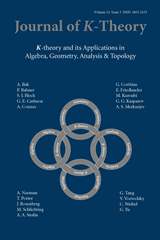Crossref Citations
This article has been cited by the following publications. This list is generated based on data provided by
Crossref.
Ara, Dimitri
Groth, Moritz
and
Gutiérrez, Javier J.
2015.
On autoequivalences of the $$(\infty , 1)$$ ( ∞ , 1 ) -category of $$\infty $$ ∞ -operads.
Mathematische Zeitschrift,
Vol. 281,
Issue. 3-4,
p.
807.
Ara, Dimitri
and
Maltsiniotis, Georges
2018.
Un théorème A de Quillen pour les ∞-catégories strictes I : la preuve simpliciale.
Advances in Mathematics,
Vol. 328,
Issue. ,
p.
446.
Paoli, Simona
2019.
Simplicial Methods for Higher Categories.
Vol. 26,
Issue. ,
p.
3.
Bergner, Julia E.
and
Rezk, Charles
2020.
Comparison of models for (∞,n)‐categories, II.
Journal of Topology,
Vol. 13,
Issue. 4,
p.
1554.
Ozornova, Viktoriya
and
Rovelli, Martina
2020.
Model structures for (∞,n)–categories on
(pre)stratified simplicial sets and prestratified simplicial spaces.
Algebraic & Geometric Topology,
Vol. 20,
Issue. 3,
p.
1543.
Maehara, Yuki
2020.
Inner horns for 2-quasi-categories.
Advances in Mathematics,
Vol. 363,
Issue. ,
p.
107003.
Campbell, Alexander
2020.
A homotopy coherent cellular nerve for bicategories.
Advances in Mathematics,
Vol. 368,
Issue. ,
p.
107138.
Rasekh, Nima
2021.
Quasi-categories vs. Segal spaces: Cartesian edition.
Journal of Homotopy and Related Structures,
Vol. 16,
Issue. 4,
p.
563.
Ozornova, Viktoriya
and
Rovelli, Martina
2021.
Nerves of 2-categories and 2-categorification of (∞,2)-categories.
Advances in Mathematics,
Vol. 391,
Issue. ,
p.
107948.
Maehara, Yuki
2021.
The Gray tensor product for 2-quasi-categories.
Advances in Mathematics,
Vol. 377,
Issue. ,
p.
107461.
Campbell, Alexander
2021.
Joyal's cylinder conjecture.
Advances in Mathematics,
Vol. 389,
Issue. ,
p.
107895.
Hackney, Philip
Ozornova, Viktoriya
Riehl, Emily
and
Rovelli, Martina
2022.
An (∞,2)-categorical pasting theorem.
Transactions of the American Mathematical Society,
Gagna, Andrea
Harpaz, Yonatan
and
Lanari, Edoardo
2022.
On the equivalence of all models for (∞,2)$(\infty,2)$‐categories.
Journal of the London Mathematical Society,
Vol. 106,
Issue. 3,
p.
1920.
Riehl, Emily
and
Wattal, Mira
2022.
On $$\infty $$-Cosmoi of Bicategories.
La Matematica,
Vol. 1,
Issue. 4,
p.
740.
Batanin, Michael
and
White, David
2022.
Homotopy theory of algebras of substitudes and their localisation.
Transactions of the American Mathematical Society,
Feller, Matt
2023.
Quasi-2-Segal sets.
Tunisian Journal of Mathematics,
Vol. 5,
Issue. 2,
p.
327.
Goldthorpe, Zach
2023.
Homotopy Theories of (∞, ∞)-Categories as Universal Fixed Points With Respect to Weak Enrichment.
International Mathematics Research Notices,
Vol. 2023,
Issue. 22,
p.
19592.
Ozornova, Viktoriya
and
Rovelli, Martina
2023.
A Quillen adjunction between globular and complicial approaches to (∞,n)-categories.
Advances in Mathematics,
Vol. 421,
Issue. ,
p.
108980.
HACKNEY, PHILIP
2024.
Categories of graphs for operadic structures.
Mathematical Proceedings of the Cambridge Philosophical Society,
Vol. 176,
Issue. 1,
p.
155.
Bergner, Julia E.
2024.
Discreteness and completeness for Θn-models of
(∞,n)-categories.
Tunisian Journal of Mathematics,
Vol. 6,
Issue. 1,
p.
49.




